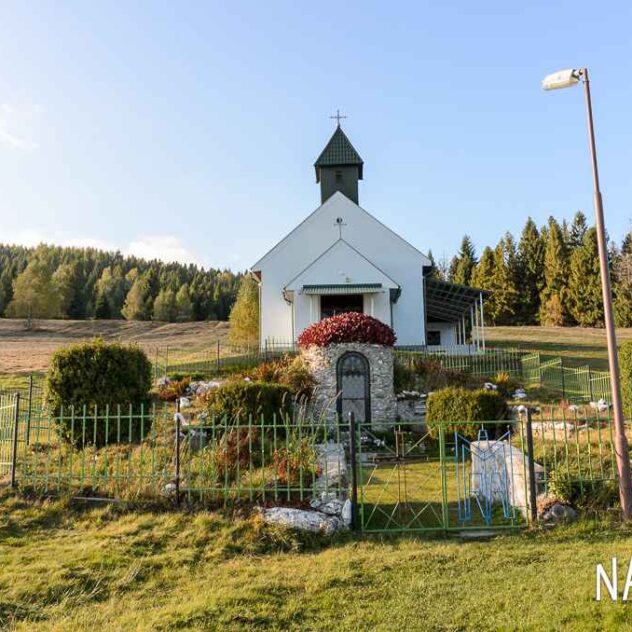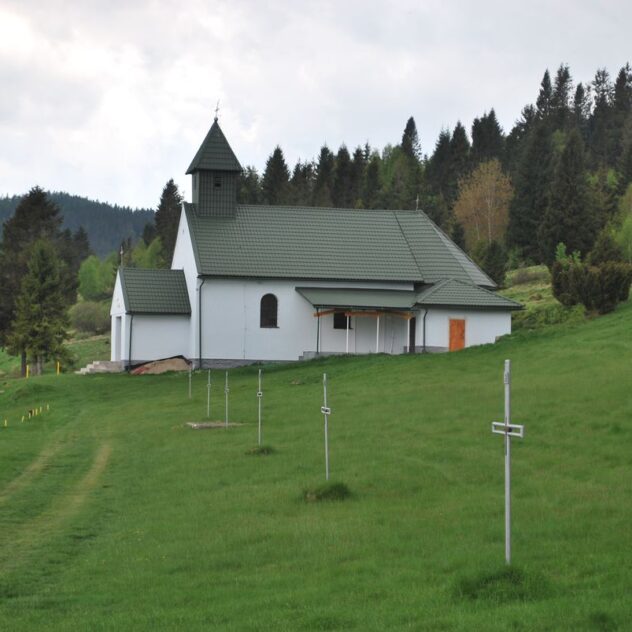Chapel of Our Lady of the Snows in Úhorná
Information about the pilgrimage site
A local legend says that in Úhorná a man found a small picture of Our Lady Help of Christians in the ground while ploughing. He could not see well what was lying on the ground. Only when he bent down and rubbed his face and eyes with the water that was in the puddle on the ground, his eyesight immediately improved. He took the picture to the church in Úhorná. However, it was lost after a year. But the next time he ploughed, he found it again in the ground. Later on, the fallen snow at this spot immediately turned to stones. This event was regarded as a miracle and as a sign from God to build a chapel. The first wooden chapel was built in 1813 by the widow Andrássy. There was also an abundant spring, which was lined with white stones. Mothers with their visually impaired children first began to come to this spring, washed their eyes with the water and many were healed.
At the spring there is also an open cave built of white stone, in which there is a statue of the Virgin Mary. This grotto dates back to 1930 and was built by the priest Štefan Herko as a thanksgiving to the Virgin Mary for his healing from a serious illness. He was being treated in the nearby Štós Spa for tuberculosis. Two years later, another grotto with a statue of the Suffering Christ was added here.
Today Úhorná belongs to the parish of Smolník in the Rožňava diocese. The pilgrimage site is visited all year round by pilgrims from near and far (during the main pilgrimage the number of visitors is around 15,000). During the main pilgrimage, which takes place regularly on the first weekend in August (the feast of Our Lady of the Snows is celebrated on 5 August), Holy Masses are celebrated not only in the Slovak language, but also in Hungarian and German. Many young pilgrims spend the night in the open air. Before the August feast, there is also traditionally a walking pilgrimage, which starts in front of the Bishop’s Office in Rožňava.
(source: Buganová K. and Piatrová A., 2009)
Tourist attractions in the vicinity
Rožňava – is an important centre of the Gemer region, which has a rich mining history, mainly iron ores were mined here. Rožňava itself has more than 700 years of history. It is worth visiting the medieval square, which is the largest of its kind in Slovakia (it has a square floor plan) and is surrounded by splendid town houses, the cathedral, the Renaissance watchtower, the town hall, the bishop’s palace and other monuments. Today, the town also hosts various cultural and social events. The Rožňava Calvary, which is one of the oldest buildings of its kind in Slovakia, is worth a visit. It is built on the southern slope where grapes were once grown. The walk to the Calvary is not difficult, less than 2 km from the Rožňava Town Hall.
Štós Bath – is unique for its natural environment. They are located in a clean and dust-free air at an altitude of 650 m above sea level, which creates excellent conditions for high intensity of infrared and ultraviolet sunlight. The air here is free of aerosols of artificial origin and the microclimate is remarkable for the purity and freshness of the air, saturated with ozone and the smell of resins. The effect of the climatic treatment is supported by speleotherapy in the nearby Jasovská jaskyňa cave. The main indication of the spa is the treatment of respiratory diseases. The spa has a long tradition and very good therapeutic results.
Krásnohorská Cave – belongs to the UNESCO World Heritage List. Movement in the cave is only possible when accompanied by experienced guides and in complete caving equipment. The terrain of the cave is rugged, so the tour is associated with a certain amount of adrenaline and sports activity. There is a “Rozňava cavers’ chapel”, which until recently was considered the highest in the world. The length of the accessible part is 420 metres.
Betliar Manor – is the only preserved manor house in Slovakia after 1945, where the original furnishings and collections have been preserved. During the communist regime the noble residences were systematically devastated. The manor house was the residence of the Andrássy family, who are considered to be the most important aristocrats in Europe in the 19th century. Betliar served them as a luxurious representative residence and its architecture was inspired by English country houses as well as French architecture.
More tourist attractions in the surroundings of the Úhorná pilgrimage site can be found on the website:
- Regional Tourism Organisation Košice Region (https://www.kosiceregion.com/sk/)
Regional Tourism Organisation Gemer (https://www.regiongemer.sk/en/)
Accommodation
- Accommodation for pilgrims: accommodation for pilgrims directly in Úhorná is not available.
- Other private accommodation nearby
Availability
By car
Access by car is the fastest. From Rožňava to Úhorná (about 30 km) you can choose the road No. 549; this is the shortest but it is in a bad technical condition.
By public transport
The village of Úhorná is the most accessible by public bus transport from Košice. Current timetables at www.cp.sk.
On foot
The main walking pilgrimage to Úhorná takes place regularly around 5. August, which is the feast of Our Lady of the Snows. Pilgrims come to the pilgrimage site from the town of Rožňava and surrounding villages. The programme of the pilgrimage is published on the website of the Rožňava Diocese.
On a bicycle
From Rožňava from Úhorná along the road number 549, the terrain is very exposed, however, the cyclist has to overcome up to about 800 metres of altitude.








